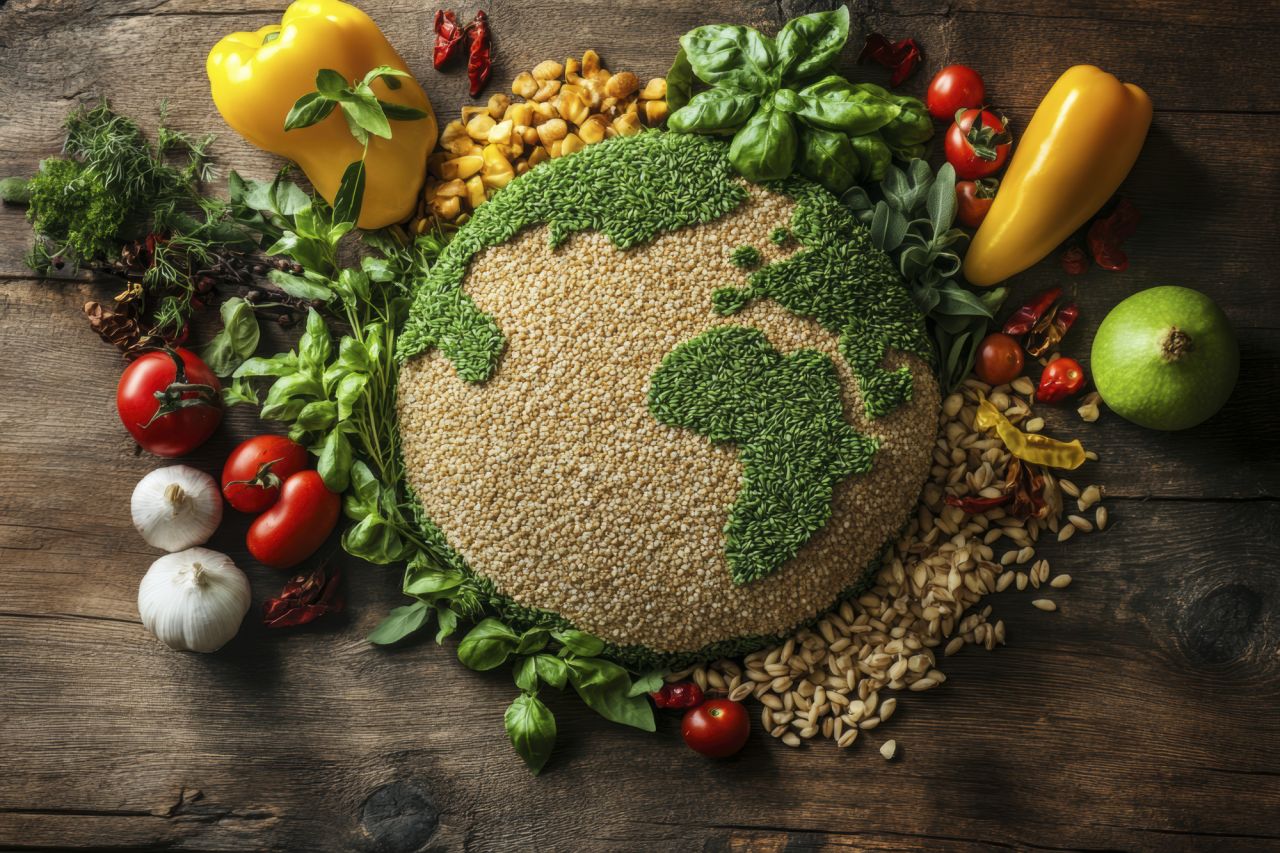Plant-Based and Lab-Grown Foods: Revolutionizing the Food Industry


Cut through the green tape
We don't push agendas. At Net Zero Compare, we cut through the hype and fear to deliver the straightforward facts you need for making informed decisions on green products and services. Whether motivated by compliance, customer demands, or a real passion for the environment, you’re welcome here. We provide reliable information—why you seek it is not our concern.
In recent years, the food industry has witnessed a significant shift toward alternative protein sources, with plant-based and lab-grown foods leading the charge. This movement is not just a fleeting trend but a substantial revolution that has the potential to reshape the industry as we know it. As consumers become increasingly concerned about health, sustainability, and animal welfare, the demand for innovative food options that address these issues is on the rise.
The Growing Popularity of Plant-Based Foods
Plant-based foods, once a niche market primarily catering to vegetarians and vegans, have exploded into the mainstream. Products like Beyond Meat and Impossible Foods have made it easier for consumers to choose plant-based options without sacrificing the taste and texture of traditional meat.
Many consumers are turning to plant-based diets to reduce their risk of chronic diseases like heart disease, diabetes, and obesity. Plant-based foods, which are often lower in saturated fats and cholesterol, appeal to health-conscious individuals.
The environmental footprint of plant-based foods is significantly smaller than that of animal agriculture. Producing plant-based proteins requires less land, water, and energy, making them a more sustainable choice in the face of climate change.
The ethical implications of animal farming, including concerns about animal welfare and the use of antibiotics and hormones, have led many consumers to seek cruelty-free alternatives.
The Emergence of Lab-Grown Foods
Lab-grown, or cultured, meat is another groundbreaking development in the food industry. Unlike plant-based meat, which is made from plant proteins, lab-grown meat is produced by culturing animal cells in a lab environment. This technology has the potential to revolutionize the way we produce and consume meat:
Lab-grown meat has the potential to reduce the environmental impact of meat production significantly. It requires fewer resources and emits fewer greenhouse gases compared to traditional livestock farming.
Since lab-grown meat is produced from cells rather than whole animals, it offers a humane alternative to conventional meat production.
Lab-grown technology opens up possibilities for producing a wide range of meats, including those that are rare or difficult to farm traditionally, such as exotic meats or even endangered species, without harming the environment or animals.
The Science Behind Lab-Grown Meat: A Step-by-Step Process

Cell Sourcing
The process of making lab-grown meat begins with the selection of animal cells, usually from a living animal through a biopsy. The cells chosen are typically satellite cells or myoblasts, which are precursors to muscle cells. These cells can proliferate and differentiate into muscle tissue, the primary component of meat.
Cell Proliferation
Once the cells are isolated, they are placed in a nutrient-rich culture medium that mimics the conditions inside an animal's body. This medium typically contains essential nutrients, amino acids, sugars, salts, and growth factors that support cell growth and division. The cells are kept in a bioreactor, a device that provides a controlled environment with the optimal temperature, pH, and oxygen levels for cell proliferation. Over time, the cells multiply, creating a large number of muscle precursor cells.
Differentiation and Tissue Formation
After sufficient proliferation, the muscle precursor cells are induced to differentiate into mature muscle cells. This process involves changing the culture conditions, such as altering the nutrient composition or mechanical stimulation, to encourage the cells to form muscle fibres. In some cases, scaffolds made from edible or biodegradable materials are used to provide structure and support for the cells, allowing them to grow into three-dimensional tissue that closely resembles traditional meat.
Maturation and Harvesting
The muscle tissue is allowed to mature in the bioreactor, where it continues to develop the texture, flavour, and appearance of conventional meat. The tissue may undergo additional processes, such as electrical stimulation or the addition of fat cells, to enhance its quality and nutritional profile. Once the tissue has reached the desired maturity, it is harvested, processed, and prepared for consumption, much like traditional meat.
Impact on Traditional Agriculture
While some farmers may feel threatened by the shift away from animal farming, others are adapting by diversifying their crops or investing in the production of raw materials for plant-based foods. Additionally, the demand for plant-based ingredients like peas, soy, and chickpeas has created new market opportunities for crop farmers.
However, the transition is not without its challenges. The growth of alternative proteins could lead to economic disruptions in regions heavily dependent on livestock farming. This may require policy interventions and support for farmers to transition to new forms of agriculture.
Nutritional Benefits and Challenges of Plant-Based vs. Lab-Grown Foods
Nutritional Benefits of Plant-Based Foods
Plant-based meats are typically lower in saturated fat compared to traditional meat, which can help reduce the risk of heart disease.
Unlike animal products, plant-based foods often contain dietary fibre, which is essential for digestive health and can help manage blood sugar levels.
Plant-based foods are packed with phytochemicals, which have antioxidant and anti-inflammatory properties, potentially reducing the risk of chronic diseases.
Challenges of Plant-Based Foods
While plant-based proteins are improving, they may still lack some essential amino acids found in animal proteins. However, this can be mitigated by consuming a variety of plant-based sources.
Many plant-based products require fortification with vitamins and minerals, such as B12, iron, and calcium, which are naturally abundant in animal products.
Some plant-based foods are highly processed, which can reduce their nutritional value and add unhealthy ingredients like sodium and preservatives.
Nutritional Benefits of Lab-Grown Foods
Lab-grown meat can be engineered to have a more favourable nutritional profile, such as lower saturated fat or higher omega-3 fatty acids, making it potentially healthier than conventional meat.
Like traditional meat, lab-grown meat provides all essential amino acids, making it a high-quality protein source.
Since lab-grown meat is produced in a controlled environment, it does not require antibiotics or growth hormones, which are often used in traditional livestock farming.
Challenges of Lab-Grown Foods
As lab-grown meat is still in the early stages of development, there is limited long-term research on its nutritional impact, particularly regarding micronutrient absorption and bioavailability.
Like traditional meat, lab-grown meat does not contain fibre or phytochemicals, which are important for overall health and found in plant-based foods.
Economic Implications: The Cost of Transitioning to Plant-Based and Lab-Grown Foods
The cost of production for plant-based foods has decreased as demand has grown and production processes have become more efficient. However, plant-based products are still generally more expensive to produce than traditional animal products due to the cost of sourcing high-quality ingredients and the complexity of processing. On the other hand, lab-grown meat remains significantly more expensive to produce than both traditional meat and plant-based alternatives, mainly because of the need for specialized equipment and energy-intensive processes. As technology advances, both plant-based and lab-grown food costs are expected to decrease, potentially making these products more competitive with conventional meat.
For consumers, the current market pricing of plant-based foods is still higher than that of traditional meat, which can be a barrier for lower-income demographics. However, as production costs fall and competition increases, prices for plant-based products are expected to become more affordable, broadening their accessibility. Lab-grown meat is likely to be introduced as a premium product, with prices expected to drop over time as production scales and efficiencies improve. The ability of lab-grown meat to achieve mainstream market penetration will largely depend on its ability to reach price parity with conventional meat products, a goal that will require significant technological advancements and economies of scale.
The broader economic implications include potential job market shifts, where job losses in traditional farming sectors might be offset by new opportunities in the plant-based and lab-grown food industries. Moreover, as countries adopt alternative proteins at different rates, global trade dynamics may shift, potentially impacting countries that are major exporters of traditional meat products.
Environmental Impact: Can Plant-Based and Lab-Grown Foods Save the Planet?

Environmental Benefits of Plant-Based Foods
Producing plant-based proteins generates significantly fewer greenhouse gases compared to livestock farming. For instance, the production of plant-based burgers results in a fraction of the emissions produced by beef burgers.
Plant-based foods generally require less water than animal agriculture. For example, producing a pound of beef can use up to 1,800 gallons of water, whereas plant-based alternatives require much less.
Plant-based diets reduce the need for extensive land use, which is associated with deforestation, habitat destruction, and biodiversity loss. Growing crops for direct human consumption is more land-efficient than growing feed for animals.
Environmental Challenges of Plant-Based Foods
The large-scale production of certain crops, like soy, can lead to monocropping, which depletes soil nutrients and increases vulnerability to pests and diseases, potentially leading to more pesticide use.
Some plant-based foods are heavily processed and require significant energy for production and packaging, which can offset some of their environmental benefits.
Environmental Benefits of Lab-Grown Foods
Lab-grown meat has the potential to produce far fewer greenhouse gases compared to traditional livestock, as it eliminates the need for large herds of methane-producing animals.
Cultivating meat in a lab requires significantly less water and land than raising livestock. This could help preserve natural ecosystems and reduce the strain on water resources.
By reducing the demand for livestock farming, lab-grown meat could help preserve biodiversity by preventing deforestation and habitat loss associated with expanding grazing lands.
Environmental Challenges of Lab-Grown Foods
The production process for lab-grown meat currently requires a significant amount of energy, particularly in maintaining sterile conditions and the bioreactors used for cell growth. As the technology matures, improving energy efficiency will be crucial.
The environmental benefits of lab-grown meat are contingent on scaling up production in an energy-efficient manner. Current small-scale operations may not reflect the true environmental impact of large-scale production.
Regulatory Challenges: Navigating the Legal Landscape of Plant-Based and Lab-Grown Foods
As the plant-based and lab-grown food industries expand, they face a complex regulatory landscape that can either facilitate or hinder their growth. Labelling laws represent one of the major regulatory challenges for plant-based foods. Traditional meat and dairy industries have lobbied for strict labelling laws that prevent plant-based products from using terms like "meat," "milk," or "cheese." These restrictions can create confusion for consumers and limit the marketing potential of plant-based products. The situation varies globally, with the European Union imposing stricter labelling laws compared to ongoing debates in the United States, creating challenges for companies operating in multiple markets.
Lab-grown meat also poses unique labelling challenges, as it blurs the line between traditional meat and plant-based alternatives. Regulators must decide whether lab-grown products can be labelled as "meat" and, if so, how they should be distinguished from conventional meat. Clear and transparent labelling is crucial to inform consumers and ensure fair competition. Both plant-based and lab-grown foods must navigate food safety standards, with plant-based products generally facing fewer hurdles due to the familiarity of their ingredients. Lab-grown meat, however, is considered a novel food and must undergo rigorous safety assessments before it can be sold to consumers.
Government support plays a crucial role in fostering innovation within these industries. Public funding for research and development can accelerate technological advancements, while incentives for sustainable practices, such as tax breaks or grants, can encourage companies to adopt more environmentally friendly production methods. However, governments must balance regulation with innovation, ensuring that necessary safeguards are in place without stifling growth. Harmonizing global standards and regulations is also essential as these industries expand internationally, facilitating global trade and market access for alternative proteins.

More related content

Extended Producer Responsibility (EPR) for Packaging: Country-by-Co...

What Is Scope 3? Understanding Indirect Emissions and Their Regulat...

The EU's Omnibus Proposal: A Deep Dive
